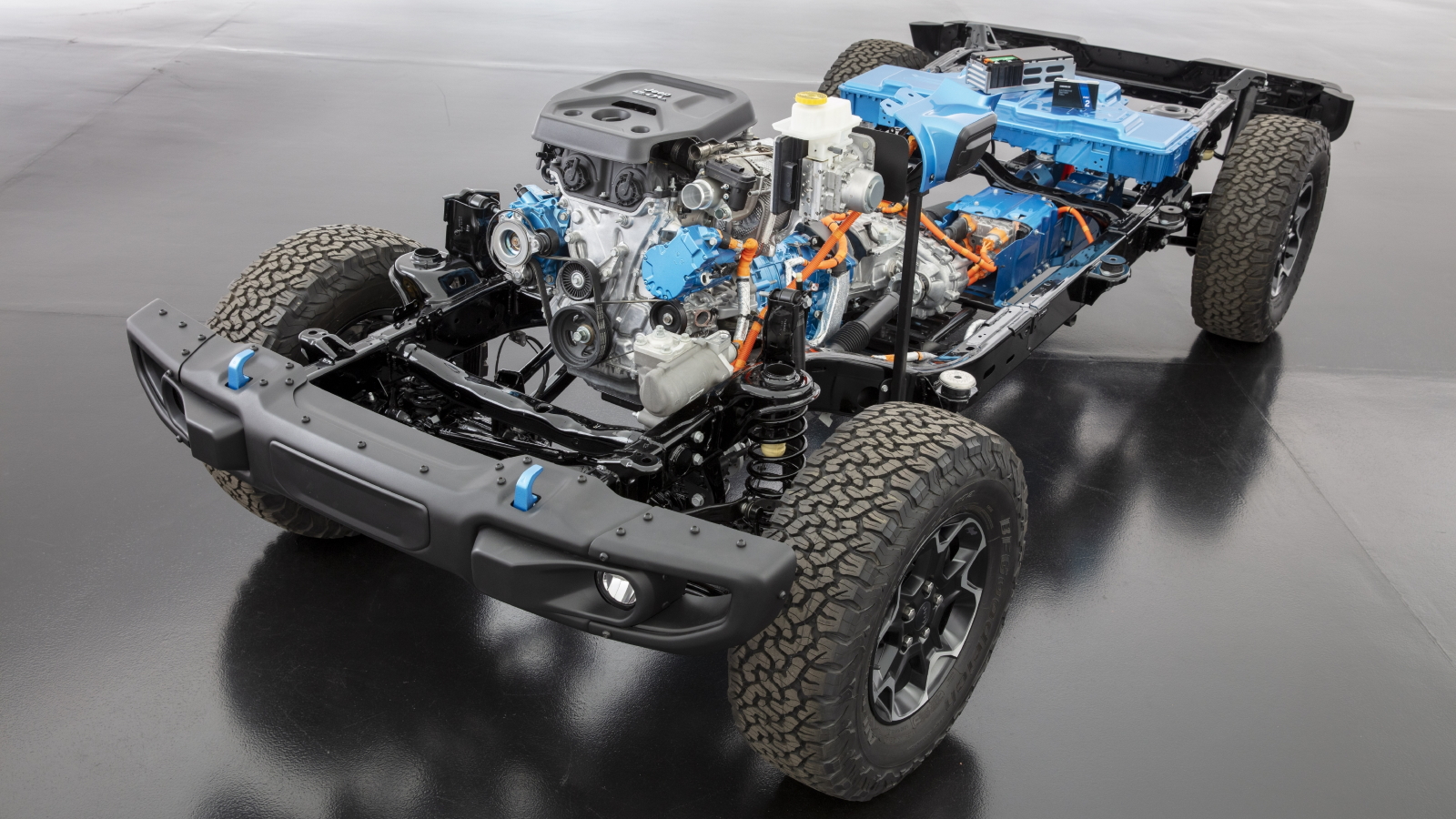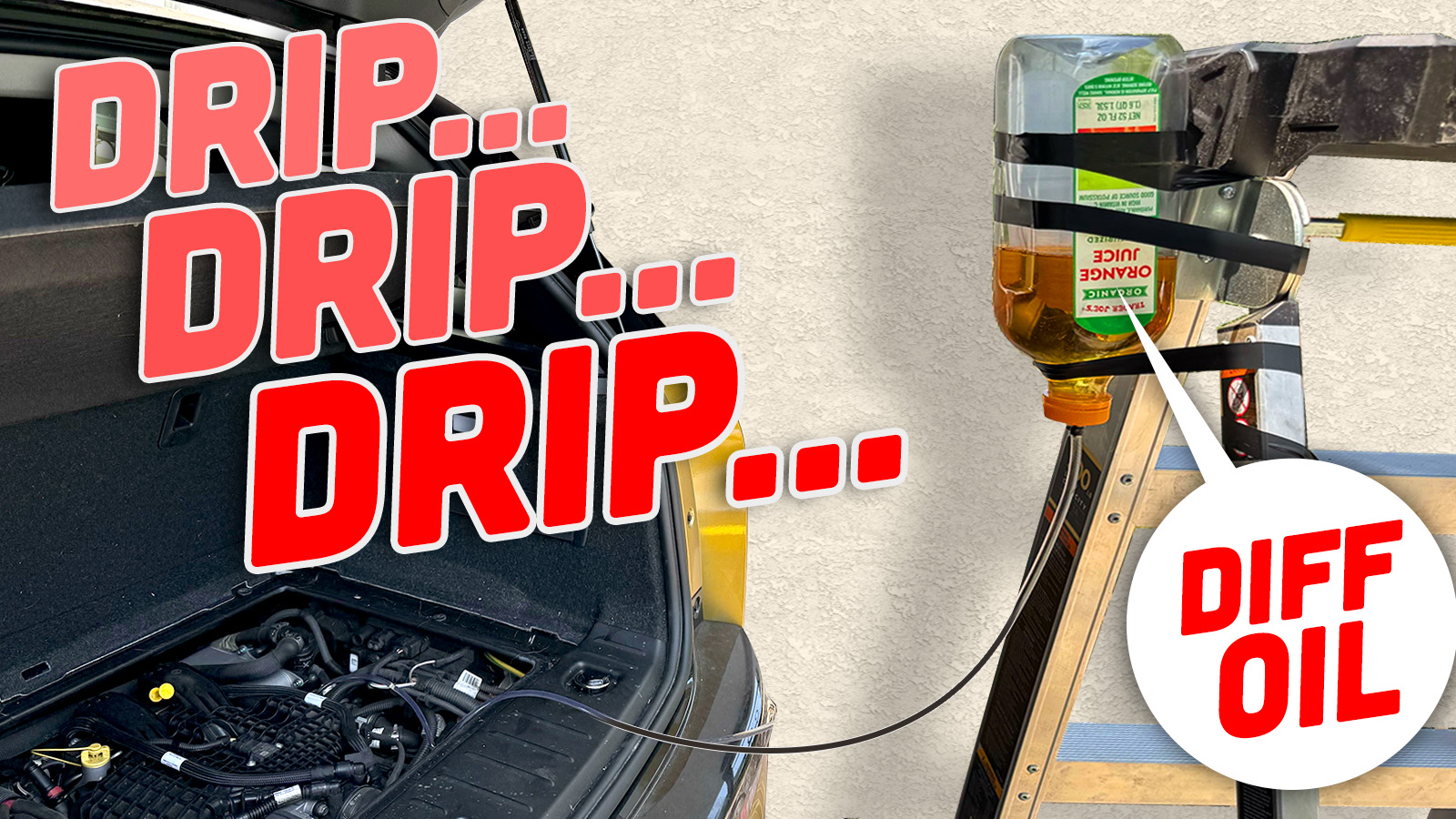It took longer than expected, but it seems that diesel is finally dying in North America. The latest casualty is the Jeep Wrangler EcoDiesel, and Jeep is sending it out on a high note with the Rubicon FarOut.
If you live and breathe the seven-slot grille, you likely remember the Gladiator Farout concept from the 2021 Moab Easter Jeep Safari. This one-off overlanding special packed a ton of off-road hardware, but four big highlights were special grey paint, a black hood graphic, a black grille, and the EcoDiesel engine.

While Jeep is showing off the Wrangler Rubicon FarOut in a different shade of grey, that special grey, the diesel engine, Rubicon base, black grille, and concept of a black hood graphic all carry over from that Gladiator concept. In addition, the Wrangler Rubicon FarOut dials up the luxury with body-color fender flares, LED lights, heated leather seats, and a bevy of advanced driver assistance systems. Unique alloy wheels and all-weather floor mats provide extra style and functionality, while special 3.0 D badging is the cherry on top of this diesel Jeep sundae.

While I really appreciate the availability of a diesel-powered Wrangler, it’s still not a product that made a ton of sense to me. While 442 lb-ft of torque sounds awesome for rock crawling, the EcoDiesel engine carried a steep surcharge. What’s more, diesel engines generally make sense for drivers who do a lot of highway mileage and the Wrangler never struck me as a highway vehicle. Don’t get me wrong, refinement has come a long way since the YJ Wrangler Renegade my best friend and I once fixed up, but the steering in the current Wrangler still feels a bit like a suggestion box. Add in susceptibility to windshield chips and crosswinds, and it’s a bit difficult to justify a Wrangler as a highway commuter.

However, Wranglers make excellent urban commuters. They skip right over frost heaves and potholes, offer a great vantage point for seeing around double-parked box trucks, and even the four-door model is several inches shorter than a Honda Accord. This is where the Wrangler 4xe really comes into its prime. While 21 miles of all-electric range from this plug-in hybrid off-roader isn’t a ton, it’s more than enough for many peoples’ daily errands. Add in a whopping 470 lb.-ft. of torque and a tax credit due to being made in America, and suddenly the 4xe looks a lot more attractive than the EcoDiesel.
The Jeep Wrangler Rubicon FarOut is available to order from now through November, with deliveries starting late this year. For those who miss out on the FarOut but still want a diesel Jeep with a solid front axle, don’t panic. The Gladiator pickup truck will still be available with the EcoDiesel engine.
Lead photo credit: Jeep






A little disappointed in this farewell package. Just a loaded Rubicon with Gladiator wheels. I would’ve loved to see yellow accents in place of the red or blue (4xe). Maybe upgraded shocks from the 392 or Mojave?
Happy I ordered mine when I could (first batch of ’21s). I’ve had Wranglers as daily drivers for most of the past two decades. This one is by far the easiest to live with. I had the gen2 in a Grand Cherokee and knew it would fit the Wrangler perfectly. Heavy, but worth it. Diesel is still 260 lbs lighter than the 4xe (200 lbs lighter than the 392), with similar torque figures.
I have 37″ tires on beadlock wheels, drive in the mountains, and still get 24+ mpg (28.5 on a 500-mile trip to Denver this summer!!) that a build-up 4xe can’t touch. I tow boats, campers, and other smallish trailers. I do overland trips whenever possible. Road trips usually involve the road less traveled for big chunks. And that sweet, sweet diesel clatter with the doors and top off are hard to beat.
DEF Killed diesels for me.
That being said I appreciate Jeep giving notice of stopping production of the diesel Wranglers before they stop production.
Smart one day said they were going to stop selling Smart cars in the US and YOU COULD NOT place a new order, as soon as they made the announcement they stopped all new orders. I would have bought an electric Smart Car if they gave us some warning before stopping new orders for the US market but instead they didn’t and I am Smart Car-less.
Even GM gave a warning when they killed the Spark a month ago! They announced it 6 months in advance.
Yep, I literally called the closest Smart dealer to me to see if I could place an order and they said ‘NOPE!’
Are they fitting american diesels with too small urea tanks, or why it’s an issue? Most DEF requiring diesels I know require update max every 10k or so, so pretty much if you change oil, you up the DEF.
The emissions systems that come along with DEF systems usually crap out at 80-100K miles and usually require the engine to be pulled in order to repair or replace them and it costs several thousand dollars at the minimum to do so.
Also in general I dislike extra fluids in a car.
The only reason I see for diesel is for the torque when hauling stuff. It no longer makes sense with most passenger cars. By the time you add in DEF and pay for the diesel, any savings for better gas mileage is eaten up over a similar gas engine, not to mention the initial outlay for the diesel engine over a gas one. Not sure how it is other places, but diesel is about 70 cents per gallon more than premium gas and about $1.20 over regular where I live. The days of the diesel being significantly better for gas mileage are long over. In the old days, the price differential was much closer together and diesel cars got much better mileage. In the 84 Rabbit, it got 11mpg better, a significant difference in both mileage and in savings. Today, while you might get more torque, you are going to pay more at the pump.
Now for a truck that hauls and tows heavy loads, the diesel makes some sense, otherwise, it really doesn’t.
Now a plug in hybrid such as the 4xe that Thomas talks about is a much better prospect in this day and age. Whenever I get rid of my Flex, I will be looking for a plug in, I commute a little over 8 miles round trip every day, so even a small electric range will be helpful, especially given the fact that I live on a mountain, go down into a valley and then climb out of the valley going up to the edge of another mountain, all on stop and go surface streets. My mileage sucks!
usually Diesel engines have better longevity, when off-road they have fewer electronic bits to fail and they can lug along at IDLE without stalling usually. They also actually tend to like heat, but you still have to watch the exhaust gas temps. Before EGR systems, the diesels were a lot more enticing, but the current stuff is almost as neutered as DOD gas motors.
1. Jeep waited WAY too long to give the wrangler a diesel engine. This should have been a JK option.
2. The VM3.0 was the wrong engine. It was the engine they had, but it was the wrong one. Wrangler buyers didn’t want an extremely heavy, complicated, super expensive but overpowered engine option. They wanted diesel efficiency.
The VM Motori R 428 from the Liberty was the engine Wrangler buyers wanted. 160 hp? Meh…but enough. 295 lbs-ft right down low? Yes, please. Simple, light, cheap. Granted that engine wasn’t going to meet current emissions standards but its successor did and you can still buy on in a Chevy. That engine WAS available in other markets up until 2018, with 197 hp and 339 lbs-ft. PERFECT levels for a Wrangler. That engine was getting 25-30 mpg in a Wrangler and didn’t have nearly the compromises as the 3.0.
Jeep knew it was the wrong engine, but they figured they had it and they knew it was only going to be a few years anyway so why not.
Honestly, the PHEV is the objectively better choice to a diesel anyway as you get a useful amount of zero-emissions travel, you get all the power and torque you could want and the efficiency, while not as good as a small diesel, is pretty good. The trouble is that the PHEV is proving to be complicated and trouble-prone.
I have to agree with this assessment.
I’ll agree that the R428 is a great engine. I have (basically the same thing) in my 2019 ZR2 colorado, its a fantastic engine, despite being a bit slow. That being said, compared to the thirsty lacking torque v6 with its garbage 8 speed automatic, I’d say its by far the better engine.
25 mpg in a lifted 31 inch tire off road pickup is pretty damn good all things considered.
This x1000
They waited way too long to give it diesel power. It should’ve started in the 70s if not earlier. I’m surprised they didn’t offer it on the YJ because AMC was owned by Renault at the time.
The Cummins 2.8 would’ve also been a good engine to use on the JL. Cummins actually sells it as a crate engine, and people have installed them in JK/JL Wranglers.
However, the VM R428 would be good too.
You mean like the CJ-10? I stared at the power train of one of those with the little Nissan diesel for a LONG time (way longer than I’d like to admit) for consideration in an FC170.
Now I have neither.
The Cummins 2.8 crate was sadly never intended to be given EPA certification for production vehicles. It basically meets minimum requirements for pre 2000’s emissions compliance and calls it a day.
Interestingly, the EU-spec Wrangler JL is (or was?) available with a 2.2 Fiat Multijet II. 4-cylinder turbodiesel.
I can’t imagine the 3.0 VM V6 pollutes less, but I’m sure FCA has some reason why the Multijet was skipped on the US-spec JLs.